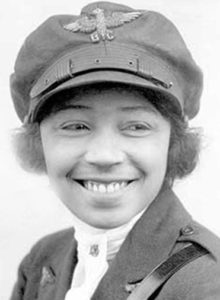 Bessie Coleman aka Elizabeth Coleman (1892 – 1926), an aviator was a star of early air shows. She was the first African-American woman to earn an International Pilot’s License. Coleman was born in Atlanta, Texas. One of 13 children, Coleman grew up in Waxahatchie, Texas. Her parent were sharecroppers. She attended a small, segregated school and helped her family by working in the cotton fields. Before joining her brothers in Chicago, she briefly attended college in Langston, Oklahoma. In Chicago she worked as a manicurist and restaurant manager. While listening to her brothers’ tales of WWI French female pilots, Coleman became intrigued and inspired to pursue a career in aviation.
Bessie Coleman aka Elizabeth Coleman (1892 – 1926), an aviator was a star of early air shows. She was the first African-American woman to earn an International Pilot’s License. Coleman was born in Atlanta, Texas. One of 13 children, Coleman grew up in Waxahatchie, Texas. Her parent were sharecroppers. She attended a small, segregated school and helped her family by working in the cotton fields. Before joining her brothers in Chicago, she briefly attended college in Langston, Oklahoma. In Chicago she worked as a manicurist and restaurant manager. While listening to her brothers’ tales of WWI French female pilots, Coleman became intrigued and inspired to pursue a career in aviation.
Coleman’s efforts to receive flight training in the United States were met with an impenetrable barrier. Discrimination blocked fight instruction for African Americans, Native Americans, and women. Because of her gender and her race, no aviation school would enroll her. Robert Sengstacke Abbott, publisher of the Defender learned of Coleman’s desire to become a pilot and urged her to go abroad in pursuit of her dream. Coleman studied and became proficient in French. In 1920 Coleman was accepted at the Caudron Brothers School of Aviation in Le Crotoy, France. Robert Sengstacke Abbott and Jesse Binga, a banker, assisted with her tuition. On June 15, 1921, Bessie Coleman became the first American woman to obtain an international pilot’s license.
Although Coleman’s return to America received national attention and she was given a hero’s welcome, American racism and gender biases continued to lock her out of a career as a commercial pilot. Undaunted, Coleman was determined to make her livelihood through flying, she set her sights on becoming a stunt pilot. This goal required additional, extensive training. Coleman returned to Europe for advanced flight training. In 1922 she made her first appearance as a barnstormer (stunt pilot) in an American airshow honoring veterans of an all-Black infantry unit. Bessie Coleman’s repertoire included many death defying stunts such as walking on her plane’s wings, hanging from the plane, parachuting, and flying in loops. She became a star admired by both Blacks and Whites. Her flying expertise earned her the title “Queen Bess”. She was also known as “Brave Bess”.
Bessie Coleman and her mechanic died in a tragic plane crash in 1926. Her pioneering role stood as an inspiration to early pilots and African Americans. Her determination, tenacity, courage, and fortitude continue to stand as beacons on the road to success.
Source: Gigi Coleman, Grand Niece of Bessie Coleman
